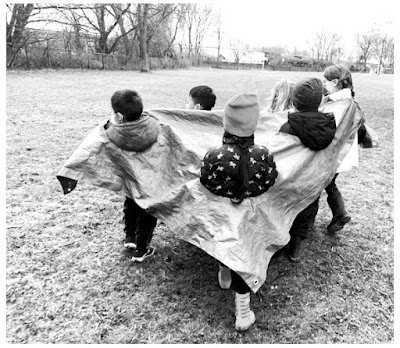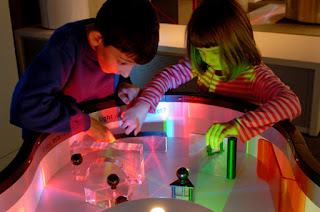MUSEUM NOTES
Jeanne Vergeront
Vergeront Museum Planning
 |
| Photo credit: Aaron Senitt, Guelph, Ontario Canada Seeing, Un-seeing, Re-seeing |
These shifts of seeing again are precisely what the word ‘respect’ means. To look again is to ‘respect.’ Each time we look again at the same thing, we gain respect for it and add respect to it.
James Hillman, City and Soul
Over the past few years, I have been thinking about observation and its value as a tool for learning, stretching our thinking, seeing new possibilities, and being better museums.
Daily, we walk through our museums and what do we notice? We watch a family move through the lobby and pause before the door to a gallery. What is this moment about for them? We see someone step in front of a painting and lean in, peer closely at the lower right hand corner, and step back again. What new insight has that closer look added? We watch someone slowly brush away gravel to reveal the form of an enormous bone. What happens next? What does it mean for them? What might we do differently knowing this?
These, among so many questions, reveal our on-going search for a deeper understanding of visitors and a greater familiarity with the conditions that encourage and support exploration and meaning making in museums. So much is going on in a single exhibit, program, gallery, or classroom in any one moment. Without thoughtful observation, what can we know and understand about what is happening around us in our museums, in the experiences we create, and the connections we hope to foster?
Yet, as powerful and valuable as observation is in advancing our understanding, thinking, and imaginations, we rarely engage in it extensively in museums–at least, from my experience and in my own work.
 |
| Photo credit: Vergeront |
Brief observation episodes that are ends in themselves or serve other agendas have a limited capacity to build new knowledge with long-term value that changes perspectives and reveals new possibilities about how people interact with objects and learn in museums.
With this view of observation, we are unlikely to take time to study how families explore together in our museums; how visitors negotiate turn-taking with one another; how children of different ages approach open-ended materials; what traces of use and engagement visitors leave to offer glimpses into their thinking; what having an idea looks like; and what building on someone’s idea looks like.
What We Don’t Already See
How do we go beyond the obvious behaviors we are able to identify and code and the minutes we can count to glimpse the extraordinary moments in museums and other settings?
There is no quick, easy, or single way to engage in deeper observation. More and longer observation episodes are likely involved. Opportunities to think together, to frame shiny questions are important. Time to give our careful and steady attention to what is around us without deciding too soon what is before us is critical. In opening ourselves to being present to what is happening we can create room to notice what we don’t already see.
 |
| Photo credit: Reggio-inspired Network of MN |
As good observers, we must also be observers of ourselves, studying our attention, checking our assumptions, and registering our focus. Questioning ourselves as we observe reminds us that we arrive at subjective interpretations, partial findings, provisional insights, and, hopefully, new questions.
Seeing Differently
As I was working through these thoughts, the subject of observation surfaced in my Thursday study group with Lani and Tom, two retired early years educators in the Twin Cities. As these weekly conversations so often do, this one pushed my imagination not just further, but into a different realm: from seeing more to seeing differently.
Lani had marked a passage to read from Art and Creativity in Reggio Emilia: Exploring the Role and Potential of Ateliers in Early Childhood Education by Reggio atelierista, Vea Vecchi. This brief, but extraordinary account of when Vea started in the Reggio schools in the 1960’s describes her year of observation. Yes! A year of observation.
At the direction of Loris Malaguzzi, founder of the Reggio Emilia educational philosophy, Vea was asked to observe children in the school. She invited 4 children at a time into a studio space to work with paints in a nonfigurative way. Her observations of 90 children of different ages in the school continued over the year with Vea taking notes on her observations of children and their paintings. She also referred to books by more knowledgeable guides like Jean Piaget, Herbert Read, and Viktor Lowenfeld that Malaguzzi had given her. Malaguzzi then poured over her notes and the children’s paintings. He commented on her observations and shared his interpretations with her. At the end of the year, using his notes and comments, Vea wrote a report for the school on the children’s work; it later became a book.
Vea has described Malaguzzi’s strategy that changed her mental framework and identity from a secondary art educator to a professional in a new role as an atelierista. Malaguzzi helped create the conditions for change with a process of observation, formative reading, notes, discussion and shared interpretation, and documentation through which Vea unlearned her certainties and opened her eyes to the potentials of the children.
See, Un-see, Re-see
Tom called this process: see, un-see, and re-see. In observation, as in many activities we engage in, we think we are being neutral and seeing the truth. Actually we are often affirming what we already think, reinforcing beliefs we have arrived at by other means. This happens for a number of reasons. Learning, memory, expectation, and attention shape what we perceive, see, and believe. Pressures of accountability in schools and other institutions subtly insist we see what we are asked to see around standards and benchmarks. In museums we are susceptible to a dominant view of learning imported from schools that is content focused and teacher directed. We are also eager to demonstrate our value and our impact to supporters with evidence. These factors influence what we see when we observe in galleries, study exhibits, and describe museum visitors.
Even when we do see something new, we are likely to name it something else, something we have seen before. Twentieth century philosopher and public intellectual, Marshall McLuhan, expressed this as, “I wouldn’t have seen it if I hadn’t believed it.”
Realistically, un-seeing is difficult, if not literally impossible. But we can work to undo old learning, find ways to displace certainty, and see fresh versions of what we are viewing. The conditions of Vea’s extraordinary journey are not easily replicated, but her effort and goal can encourage us to observe from a new stance. We can shift our observation from looking for what we expect, to looking for what we haven’t seen before. We can be open to what surprises us.
Tom, Lani, and I thought together about what might create movement from seeing to re-seeing to create a crack in our thinking through observation by:
• Being curious, open, and eager to be surprised
• Wholeheartedly pursuing the opportunity of the moment
• Revisiting the experience and its possible meanings
When we are open, curious, and eager to be surprised, we are:
- Awake to our surroundings and the people, spaces, and materials
- Accepting uncertainty and the complexity of what we are noticing
- Comfortable with not knowing what we are seeing
- Exposing ourselves to other thinkers and knowledgeable guides
When we wholeheartedly pursue the opportunity of the moment, we:
- Are prepared to capture traces of the experience in multiple ways: notes, video, photos, images
- Are open to what we may be seeing that is contrary to the apparent direction and we follow it
- Observe until we are surprised
When we revisit the experience and its possible meanings, we:
- Return to all of the collected traces of observation: notes, photos, images, and videos
- Pursue questions to reflect on what we have noticed: how do visitors influence each other in exploring an exhibit? How do ideas about how something works change over the course of an experience?
- Attend to strategies, not outcomes: ways that individuals engage with the group; patterns of choices; leaps in thinking; the roles conversation plays
- Share, and invite others to contribute what they see
- Stretch to consider what something might mean that is beyond our imagination
- Think together: what might we do to make this or that unusual gesture or activity more likely to happen again?
This is a bigger, more complex, process than can possibly be captured here. In fact, the above list, or any list, is fundamentally at odds with deep, open-ended observation. We must keep in mind that seeing what we already see is a poor strategy for the positive change and transformation we seek for our visitors, our communities, and ourselves. Fortunately, the benefits of what Lani calls a radical openness to what’s out there and what it means are ample and worthwhile: a livelier, richer experience of our work and its potential value.
Are you ready to be surprised?
Related Museum Notes Posts
Thank you, Lani and Tom
Stand aside awhile and leave room for learning, observe carefully what children do and then, if you have understood well, perhaps teaching will be different.
Loris Malaguzzi
Originally Posted October 2017




